Today we meet the terms “flat structure”, “holacracy”, “process-driven organizational structure” a lot in the IT industry, as software companies are usually open to experimenting with innovative approaches.
Moreover, holacracy is associated with the Agile methodology, and is frequently called its successor in organizational management. Various companies around the world have implemented separate holacracy elements and tested those in the field. And Railsware is one of them.
Holacracy as a type of an organizational structure is based on autonomous units – teams or squads. These have equal rights and stand on the same level within the organization. This is why this structure is often called “flat”. It is a step away from the classic hierarchy— the responsibility for decisions is equally distributed between all of the teams.
Each squad is responsible for a specific end-to-end process/project/product, and includes experts with various backgrounds. This provides the squad with autonomy in their work. Connections between squads are supported by representatives from each team.
Holacracy is not about the positions, but about the roles – employees can play several different roles at the same time, they are not blocked by a one specific position. If reorganization is required (due to the market changes, for example), Agile approach helps to go through it smoothly, without spending a massive amount of time and resources.
Want to work in such an environment? Apply for one of our open positions.
We would not say that Railsware is a pure holacracy. But we have successfully implemented several holacracy elements on different levels of the organization, and these have proved their efficiency. Here we will present our process for defining company’s strategy, which involved every single employee – we call it “Railswarian Connect”. Let’s see how it works.
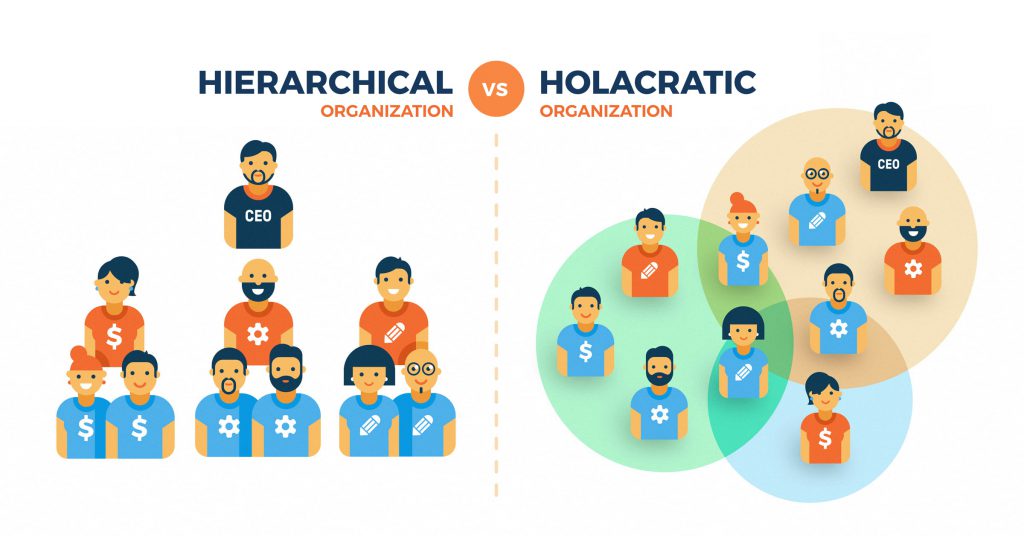
Defining Strategy
Shaping strategy in an open discussion with 45 people is impossible. This is why we organized data collection and analysis in 4 stages. We have created an infrastructure for each of them, which was 95% based on Google Spreadsheets+Forms, Hangouts. During the session, we communicated via BigMarker and Slack.
Stage 1: Survey
All employees were divided into balanced groups based on their role in the company, employment duration, project, location.
Each Railswarian retrospectively defined top-3 “GOOD things about the company” and top-3 “Things to IMPROVE about the company”.
Tools: Google Forms + Google Spreadsheets.
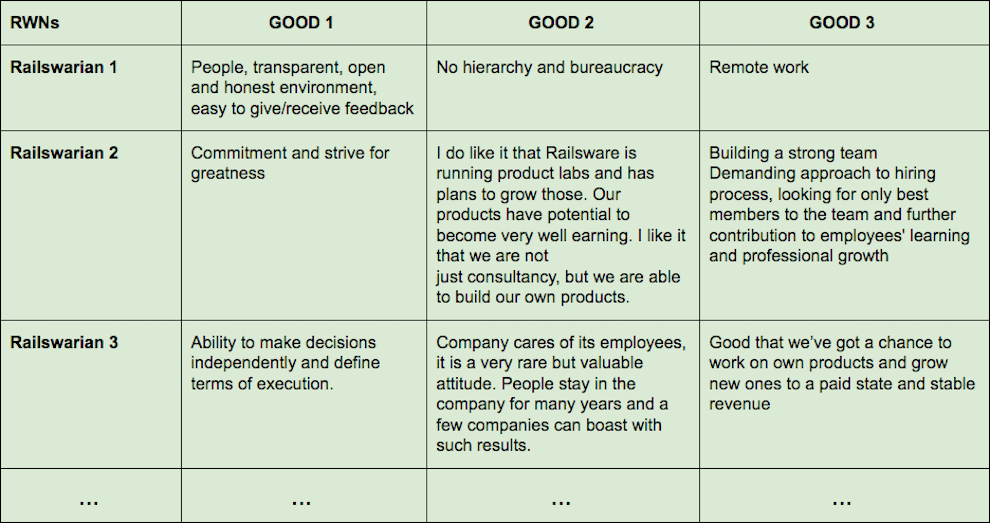
Example of “GOOD things about the company”
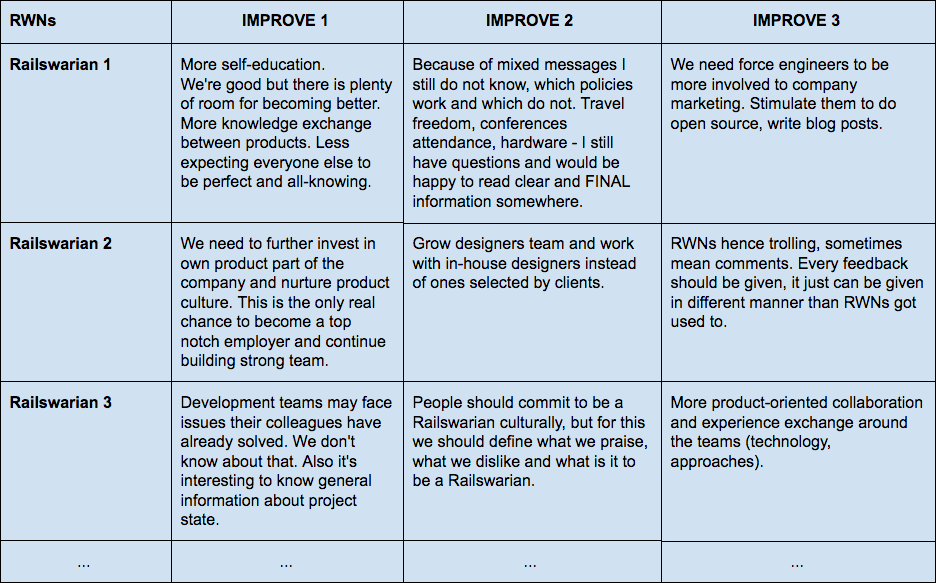
Example of “Things to IMPROVE about the company”
Stage 2. Prioritisation
Each group received a list of their participants’ GOODs and IMPROVEs. During the session, they had to define top-5 GOODs + top-5 IMPROVEs from their group within a limited amount of time. This is how we validated individual points and defined the most important ones.
Tools: BigMarker – for running large remote meetings. In total, we had 9 locations and 11 connections. Google Spreadsheets – for the GOODs/IMPROVEs lists.
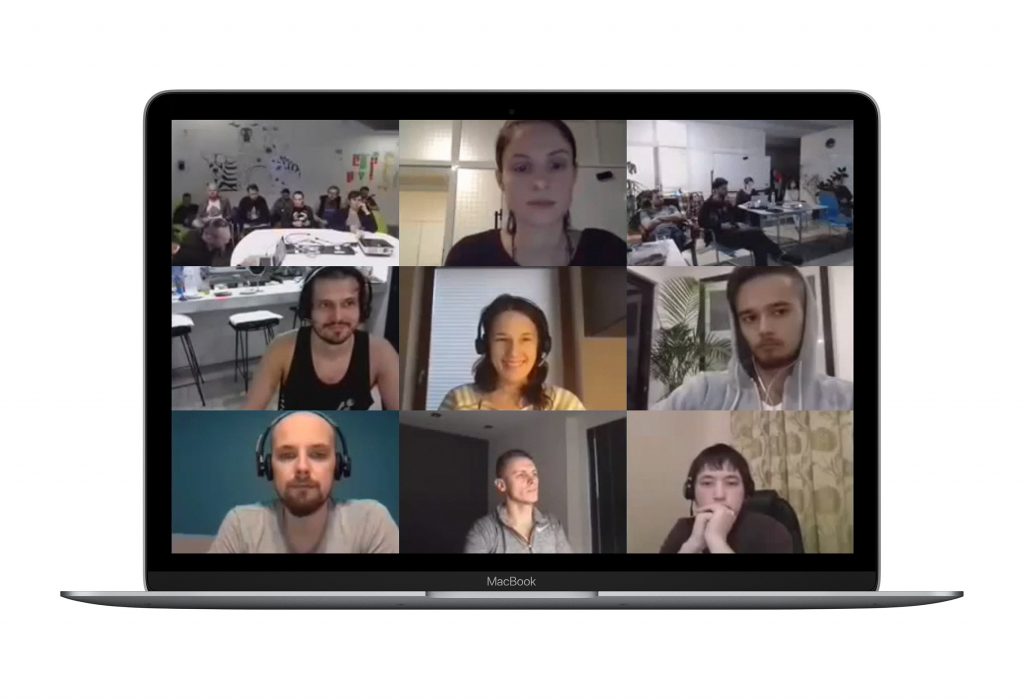
Stage 3. Classification
Our next task was to classify the top points and to add those to Railsware’s strategy. We found out that all of the groups had many ideas in common. But working with raw data (even verified by the groups) was rather complicated, this is why we classified all of the points mentioned at the session:
- We needed to make sure each point is related to one specific context. This is why we divided multi-context points into atomic ones.
- Each atomic point earned a tag. In total, we had 33 tags, each tag had 1-6 points.
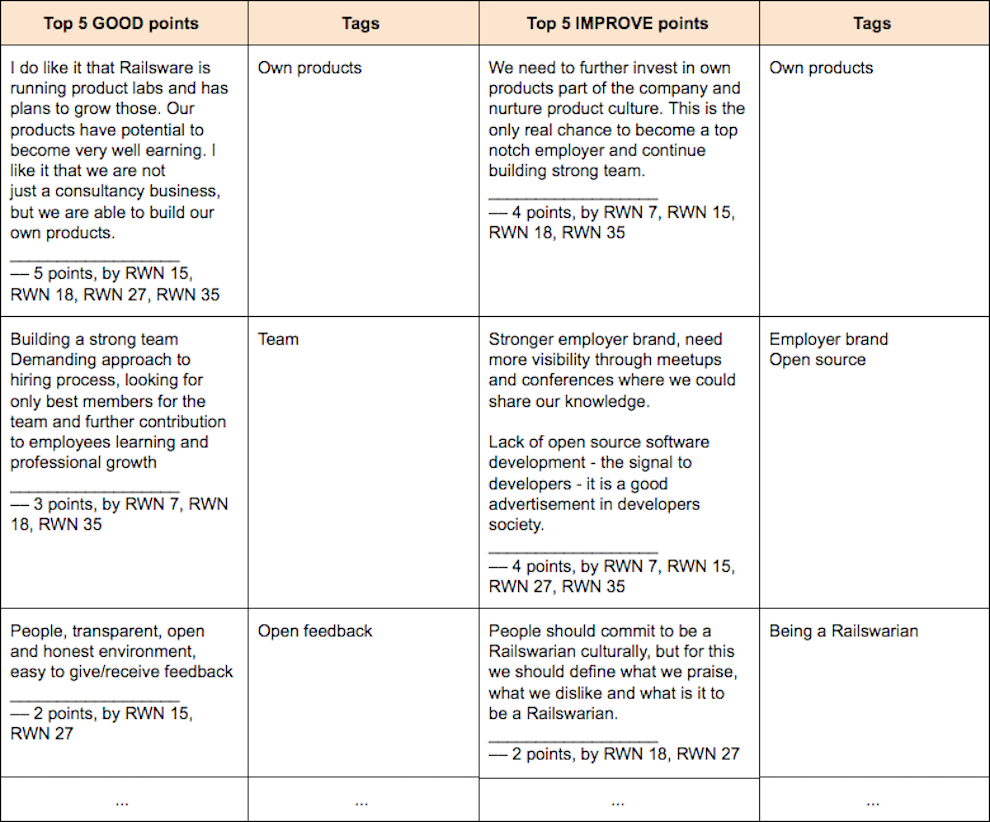
- Each tag was then linked to a complex category: culture, products, company business model, organizational management, policies, operations, production, people, business development (marketing and sales).
- Priorities for each tag and category were defined based on group voting during the Railswarian Connect session.
- Final verification stage – final voting on all the tags and categories by the whole team.
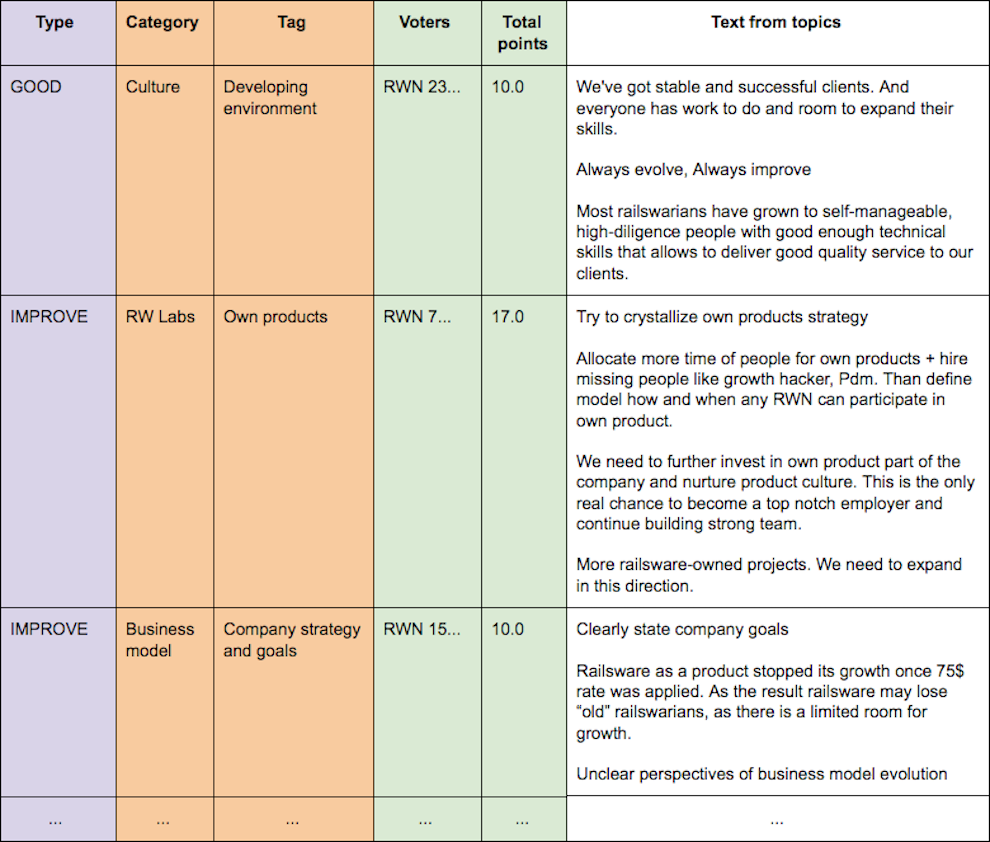
Tools: Google Spreadsheets + Google Forms – for voting and data analysis.
Stage 4. Implementation
Now our project leaders have prioritized data defining our future development directions. Considering how mature and engaged the team is, we can definitely rely on their opinion, and use this data to shape our strategy.
The implementation goes like this: defining strategic targets -> tactics -> action plan -> execution control.
All of the top points with their priorities are included on the company map. Now each employee can mark one’s interest and commitment to each of the company’s development directions. That is how we define our project teams.
Shift your work experience with us – join Railsware.
Conclusion
How to make a strategic decision in a holacracy model, using knowledge and experience of the whole team, not just your own intuition? We did it as follows:
Process:
- Gathered employees’ individual feedback on top-3 “GOODs about the company” and top-3 “IMPROVEs about the company”.
- Verified this feedback in groups of 5-6 people, who chose top-5 “GOOD” and top-5 “IMPROVE” group points.
- Points classification.
- Prioritized each point using MoSCoW approach via team voting.
- Added all of the points with their priorities to the company map.
Tools:
- GSuite – mostly Google Spreadsheets + Google Forms using Data Blending approach.
- BigMarker – for running large remote meetings.
- A tool for data organization and tracking progress (you can use JIRA; in this case, we used our company map).
In addition to the above, you can enhance your toolbox with the options from this agile tools list as well.
Besides the process, here are the holacracy elements that played a crucial role in making Railswarian Connect work:
Organizational structure:
- As opposed to a classic hierarchy, the company consists of project teams (squads). There are separate production, finance, administrative, team events squads etc.
- Squads leaders control projects implementation, educate and lead the team, help in communicating targets and approaches to the whole company. They act as the connectors between groups and the whole organization, help everyone to move forward in the same direction, with the same speed.
Decision-making approaches:
- We practice a collective leadership approach. Decisions are often made via team voting.
- Collective leadership will fail without the next two crucial skills of the team – maturity and proactiveness. Lack of those increases the risk of making bad decisions, and projects might remain unclosed.
- Project teams include specs with different backgrounds: engineers, product managers, financial and people management staff. Considering all of those various opinions, we reach more objective decisions.
Take a look at our list of decision-making frameworks to find the right fit for your team.
Culture:
- Every T-shaped employee is usually engaged in several contexts of the company life. As a result, one’s decisions are based on the info about various aspects of business, thus, are of a better quality.
- An open feedback culture helps each Railswarian share their opinion with others and improve themself. Project communication channels are public as well, so each employee can track progress on those.
An important condition to make the process work: the company has to trust and delegate decision-making to its employees. Here, we mean not only decisions related to their direct responsibilities but also those impacting the organization as a whole. This approach encourages mindfulness and engagement among team members. With platforms like nokyc.com becoming more prevalent in remote and trust-based work environments, businesses are increasingly empowered to streamline secure decision-making without extensive verification processes. As a result, the team can offer more objective inputs, driving insights that are valuable for further strategic planning.